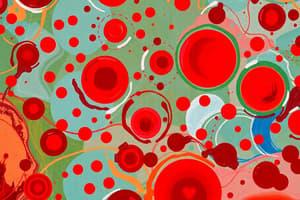Podcast
Questions and Answers
What is the primary function of eosinophils in the blood?
What is the primary function of eosinophils in the blood?
- Combat viral infections
- Neutralize histamine and mediate inflammatory responses (correct)
- Form antibodies
- Produce blood clotting factors
Which type of leukocyte constitutes the majority of blood leukocytes?
Which type of leukocyte constitutes the majority of blood leukocytes?
- Neutrophils (correct)
- Monocytes
- Eosinophils
- Basophils
What proportion of blood leukocytes do lymphocytes make up?
What proportion of blood leukocytes do lymphocytes make up?
- 2% to 4%
- Less than 1%
- 3% to 8%
- 20% to 30% (correct)
What is the lifespan of monocytes in connective tissue?
What is the lifespan of monocytes in connective tissue?
Where does hemopoiesis primarily occur in adults?
Where does hemopoiesis primarily occur in adults?
What type of leukocyte has a bilobed nucleus and is primarily involved in combating parasitic infections?
What type of leukocyte has a bilobed nucleus and is primarily involved in combating parasitic infections?
Which of the following statements about basophils is correct?
Which of the following statements about basophils is correct?
Which type of stem cell is responsible for the production of all blood cell types?
Which type of stem cell is responsible for the production of all blood cell types?
What is the primary function of erythrocytes in blood?
What is the primary function of erythrocytes in blood?
What component of blood plasma helps to regulate colloidal osmotic pressure?
What component of blood plasma helps to regulate colloidal osmotic pressure?
Which type of leukocyte contains cytoplasmic granules?
Which type of leukocyte contains cytoplasmic granules?
What is the lifespan of erythrocytes after which they are phagocytosed?
What is the lifespan of erythrocytes after which they are phagocytosed?
What is the role of platelets in the blood?
What is the role of platelets in the blood?
Which formed element of blood is known to be a very active phagocyte?
Which formed element of blood is known to be a very active phagocyte?
What percentage of blood plasma is typically composed of water?
What percentage of blood plasma is typically composed of water?
What distinguishes agranulocytes from granulocytes?
What distinguishes agranulocytes from granulocytes?
Flashcards
Eosinophils
Eosinophils
White blood cells constituting 2-4% of leukocytes, involved in immune response particularly against parasitic infections.
Basophils
Basophils
Leukocytes that make up less than 1% of blood cells, releasing histamine and heparin during allergic reactions.
Lymphocytes
Lymphocytes
A type of agranulocyte making up 20-30% of leukocytes; essential for immune defense and form plasma cells.
Monocytes
Monocytes
Signup and view all the flashcards
Hemopoiesis
Hemopoiesis
Signup and view all the flashcards
Pluripotential hematopoietic stem cell
Pluripotential hematopoietic stem cell
Signup and view all the flashcards
Life span of Eosinophils
Life span of Eosinophils
Signup and view all the flashcards
Adult hemopoietic sites
Adult hemopoietic sites
Signup and view all the flashcards
Blood
Blood
Signup and view all the flashcards
Erythrocytes
Erythrocytes
Signup and view all the flashcards
Platelets
Platelets
Signup and view all the flashcards
Leukocytes
Leukocytes
Signup and view all the flashcards
Plasma
Plasma
Signup and view all the flashcards
Colloidal Osmotic Pressure
Colloidal Osmotic Pressure
Signup and view all the flashcards
Granulocytes
Granulocytes
Signup and view all the flashcards
Neutrophils
Neutrophils
Signup and view all the flashcards
Study Notes
Blood Composition and Function
- Blood is a connective tissue with cells suspended in a fluid called plasma
- Erythrocytes, leukocytes, and platelets are the formed elements suspended in plasma
- Blood transports gases, nutrients, waste products, cells, and hormones
- Plasma is 90% water; 8% protein; 1% inorganic salts; 0.5% lipids; 0.1% glucose and other minor components
- Plasma proteins include albumin, clotting factors, anti-proteases, transport proteins and immunoglobulins; these proteins maintain the fluid distribution in the body
Blood Cell Types
Erythrocytes
- Most numerous blood cells
- Non-nucleated cells that remain within the blood
- Contain hemoglobin that carries oxygen and carbon dioxide
- Have a concave shape which increases surface area for gas exchange
- Live for about 120 days and are phagocytosed by the spleen, liver, and bone marrow
Platelets
- Specialized cells that seal damaged blood vessel walls and activate the blood clotting cascade
- Essential for haemostasis (the system that controls bleeding)
- Lack a nucleus
Leukocytes
- Contain a nucleus
- Subdivided into granulocytes and agranulocytes
- Granulocytes contain granules in the cytoplasm: neutrophils, eosinophils, basophils
- Agranulocytes lack cytoplasmic granules: monocytes, lymphocytes
Granulocytes
Neutrophils
- Cytoplasm appears clear under a microscope
- Nuclei contain multiple lobes
- Short-lived in blood or connective tissue (hours to days)
- Very active phagocytes, attracted to foreign material by chemotactic factors
- 60-70% of white blood cells
Eosinophils
- Cytoplasm filled with large pink granules
- Have a bilobed nucleus
- Phagocytic (able to engulf other cells), engulf antigen-antibody complexes
- Release chemicals that neutralize inflammatory mediators
- 2-4% of white blood cells
Basophils
- Cytoplasm contains dark blue or brown granules
- Short-lived, obscured nucleus
- Contain histamine and heparin
- Less than 1% of white blood cells
Agranulocytes
Lymphocytes
- Dense nucleus within a small cytoplasmic rim
- No granules, varying sizes
- Essential in the immune system; live for days to months
- Respond to antigens and form plasma cells when exposed to specific antigens
- 20-30% of white blood cells
Monocytes
- Largest agranulocytes, horseshoe shaped nucleus
- Live for months in connective tissue, becoming phagocytes
- 3-8% of the white blood cells
Hemopoiesis
- Formation of blood cells, varies with organism's development stage
- Initial hemopoietic site is the yolk sac; later it is taken over by liver, spleen, and bone marrow
- In adults, red marrow (found primarily in the skull, sternum, vertebrae and pelvic bones) produces red blood cells
- Hematopoietic stem cells produce all blood cell types
Studying That Suits You
Use AI to generate personalized quizzes and flashcards to suit your learning preferences.




